Georgia State Patrol
Georgia State Patrol
The Georgia State Patrol was formed on March 19 1937. It was the motoring public who first advocated the need for the Department of Public Safety. Traffic fatalities, increased crime, and a need for a larger law enforcement agency with statewide arrest powers, led Georgia lawmakers to create the State Patrol.
In the summer of 1937, the first Trooper School was held at Georgia Tech and graduated 80 Troopers. The Department of Public Safety comprised of three divisions: The first being uniformed-State Patrol, the second a division of criminal identification, detection, prevention, and investigation and the third division was for driver licensing. The first vehicles of the GSP were thirty three 1937 Fords with an 85 horsepower engine and bulletproof windshields. They were painted gun metal gray with orange lettering.
The 1950's saw a steady expansion of all levels of state policing including communications and investigative work. Illicit drug investigations were stepped-up in the 1970's and 80's. The men and women of the GSP have proven their diligence in state law enforcement at all levels including such high profile events as the Democratic National Convention of 1988, the late Winter "Storm of the Century" in March of 1993 as well as when Georgia hosted the world at the 1996 Olympic Summer Games in Atlanta.
Today, the GSP employs over 850 Troopers, 246 dispatchers, 334 license examiners and 530 civilian employees. The GSP has 48 patrol posts throughout the Peach State.
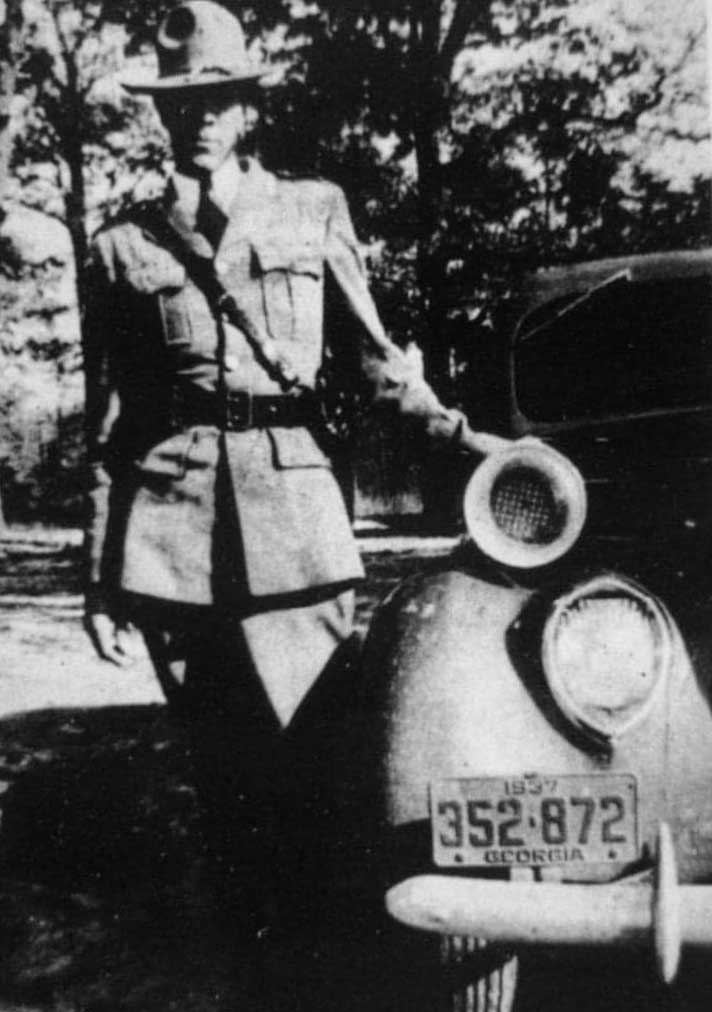 1937- First year of Georgia State Patrol. Using regular Georgia passenger license plate. Dark blue over orange. Embossed steel.
1937- First year of Georgia State Patrol. Using regular Georgia passenger license plate. Dark blue over orange. Embossed steel. 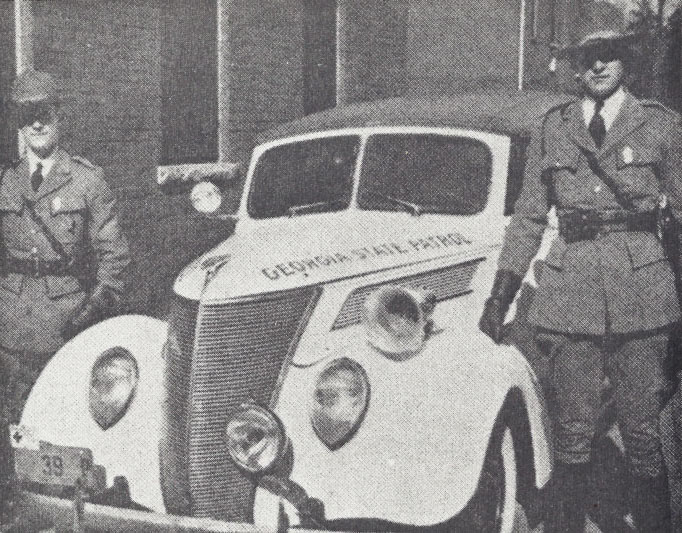 1939 issue. Dark blue over yellow.
1939 issue. Dark blue over yellow.The earliest known license plate usage by the GSP was in their inaugural year, 1937. Regular Georgia passenger license plate # 352-872 adorned the front on a newly deployed GSP squad car.
There is no record with respect to 1938, however in 1939, license plates used by the Georgia State Patrol were made of embossed steel and issued in pairs. The plates measured 5 1/4" x 12 1/2" and had dark blue characters over yellow. The year was centered at the top of the plate over up to two numbers followed by the suffix P for Patrol. The state name was centered along the bottom of the plate.
In 1940, the same size embossed steel plate was also issued in pairs, however the colors were orange over green. The word STATE was centered at the top of the plate over the prefix P followed by up to two numbers. The state name was abbreviated to GA and the year was abbreviated as 40 which can be seen in the photo below showing 1940 GSP plate # P 73.
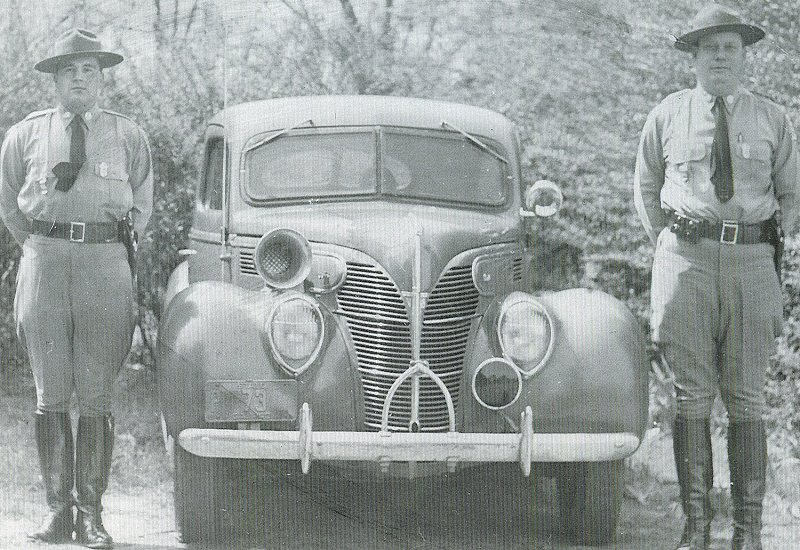
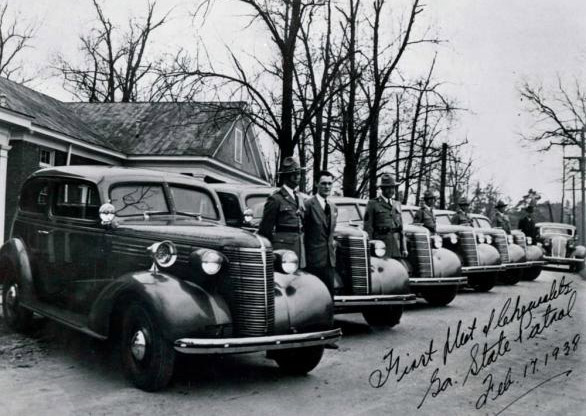 Georgia State Patrol's first fleet. February 17 1938
Georgia State Patrol's first fleet. February 17 1938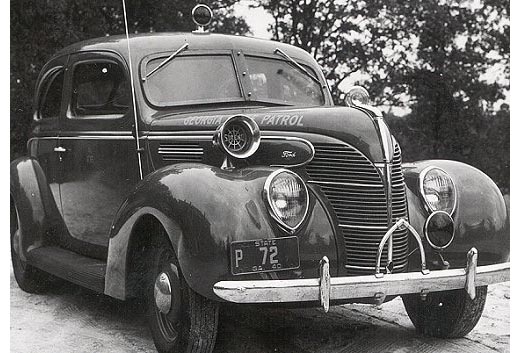 1940 GSP license # P 72
1940 GSP license # P 72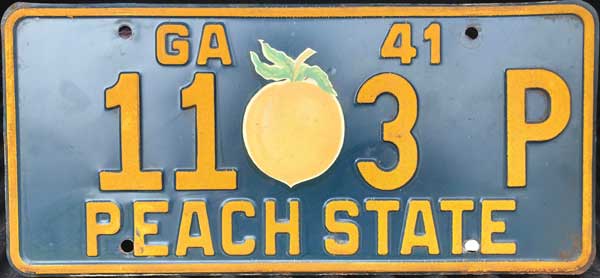 1941 issue. Embossed steel.
1941 issue. Embossed steel. 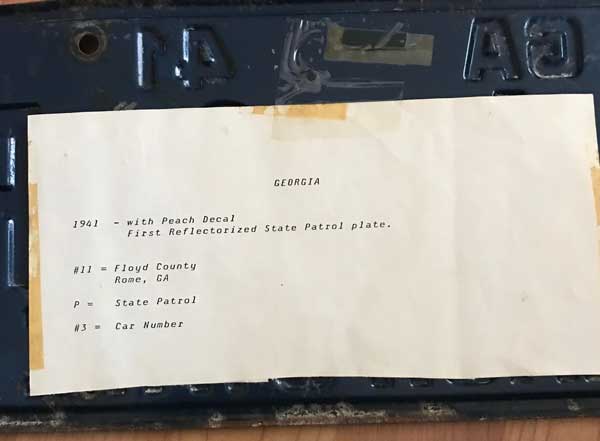 Original card that came with the plate.
Original card that came with the plate.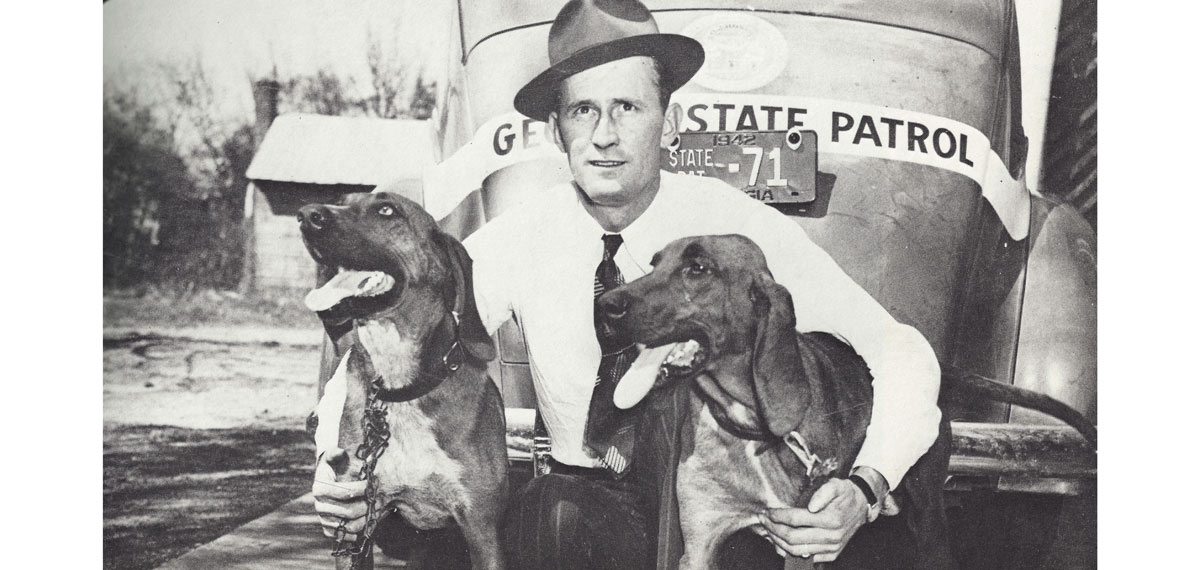
The years of 1945 until the late 1960's prove to have many gaps and lots of mystery as to what kind of license plates were used on GSP vehicles. There is not much confirmed information of use, nor are there any known surviving examples (so far) from this era. What is known for this era follows until new information, or hopefully newly-discovered images arise.
1942-1944: An embossed steel plate was issued REAR ONLY measuring 5 1/2"x 12 3/8". The colors were red and white over a blue background. The year 1942 was centered at the top of the plate. The center left of the plate had the legend STATE over PAT followed by a dash and up to two numbers. The state name GEORGIA was spelled out in full along the bottom center.
 1946 issue. Embossed steel. Black over silver.
1946 issue. Embossed steel. Black over silver.
1948: An embossed aluminum plate was also apparently issued REAR ONLY and measuring 5 1/4"x 12 1/2". The colors were black over aluminum. The top of the plate had GA 48 centered between the upper mounting holes. On the center left portion of the plate was the prefix S/P followed by a dash and up to four numbers. The base line had the state slogan PEACH STATE centered between the lower mounting holes.
1949: An embossed aluminum plate was issued REAR ONLY and measuring the same as the 1948 issue. The colors were red over aluminum. The top of the plate had GA 49 centered between the upper mounting holes. The center left of the plate had the word STATE over PAT followed by two numbers, a dash and one number. It is believed that the two numbers before the dash indicated the Post number, but this information is not confirmed. Plate number 10-3 was seen in a contemporary photograph, which we need a copy of desperately!
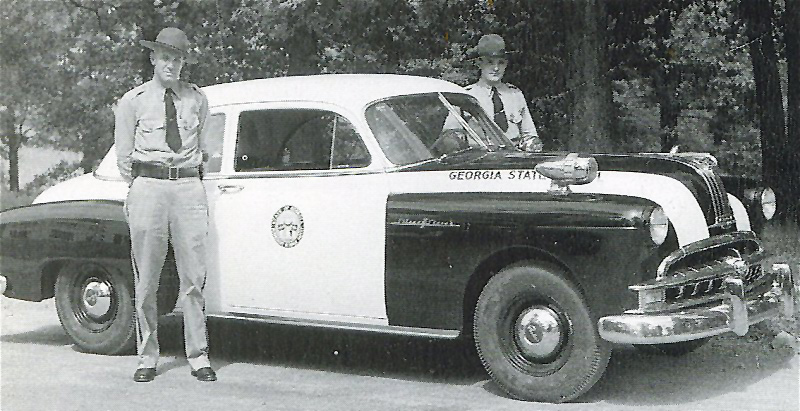
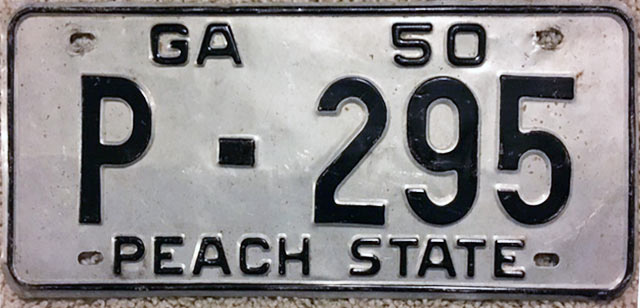 1950 P-prefix. Black over aluminum
1950 P-prefix. Black over aluminum
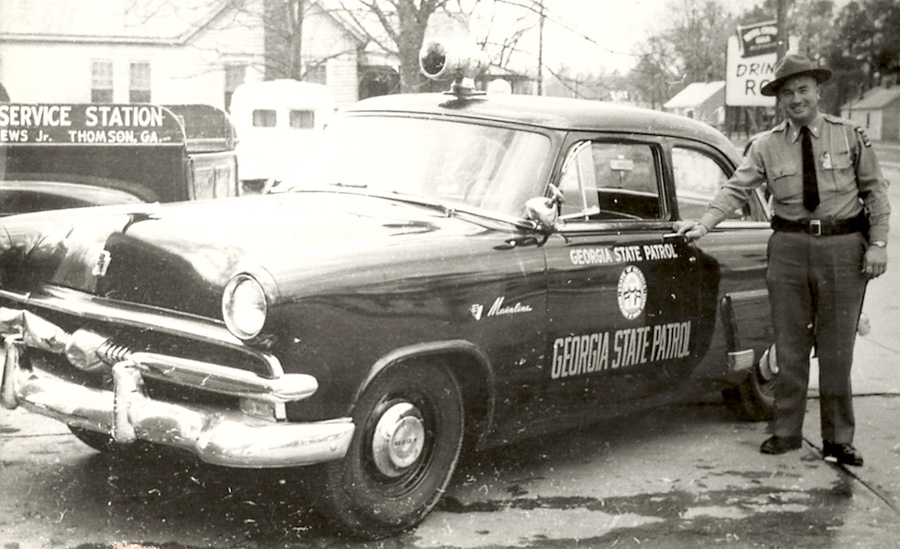
In the 1960's, the GSP began issuing confirmed "Post Plates" for their marked patrol vehicles. That year, plates were white over medium blue and followed the regular passenger format, however with a number up to two digits indicating the Post number followed by a dot seperator, the letter P for Patrol, another dot seperator and a number up to two digits indicating the car number by seniority. Post Commanders would be issued the #1 plate for their Post followed by the commensurate rank structure down to the most rookie Trooper. The bottom of the plate had 19 PEACH STATE 70 with the state slogan occupying the space between the lower mounting holes.
The Post numbers for the Georgia State Patrol for the Post series (1970-1983) is as follows:
1: Griffin 2: LaGrange 3: Cartersville 4: Villa Rica 5: Dalton 6: Gainesville 7: Toccoa 8: Madison 9: Atlanta 10: Americus 11: Hinesville 12: Thomasville 13: Tifton 14: Donalsonville 15: Perry 16: Helena 17: Washington 18: Reidsville 19: Swainsboro 20: Dublin 21: Sylvania 22: Waycross 23: Brunswick 24: Newnan 25: Thomson 26: Thomaston 27: Blue Ridge 28: Canton 29: Cedartown 30: Cordele 31: Valdosta 32: Athens 33: Milledgeville 34: Manchester 35: Jekyl Island 36: Douglas 37: Lawrenceville 38: Rome 39: Cuthbert 40: Albany 41: Lafayette 42: Savannah 43: Calhoun 44: Forsyth 45: Statesboro
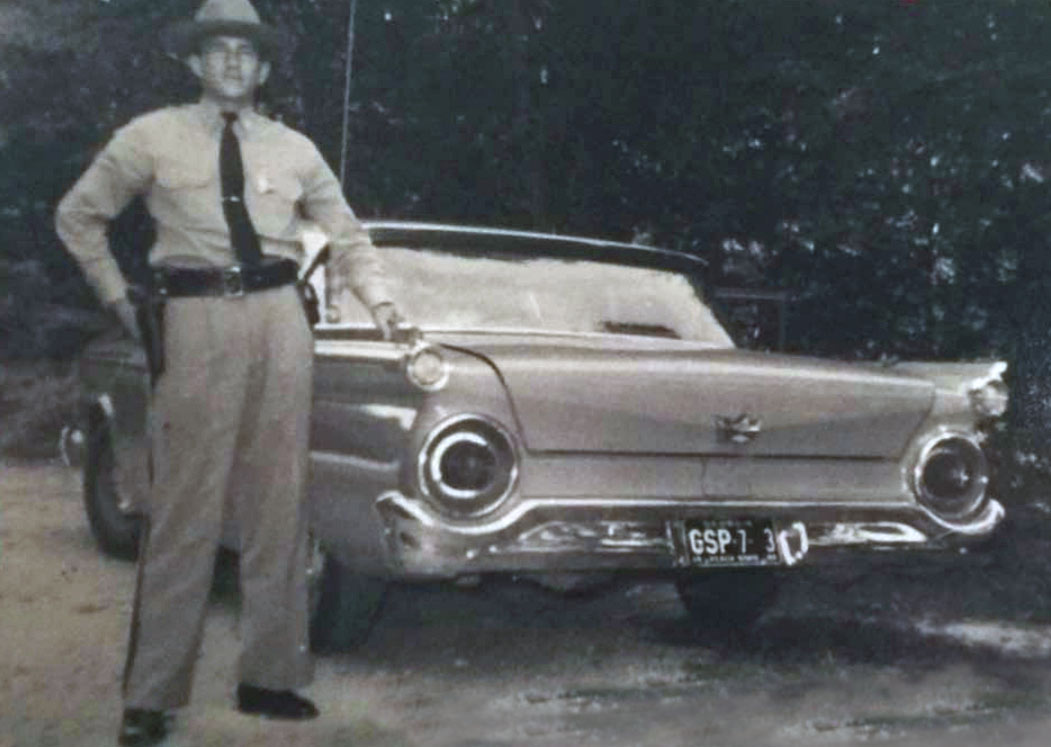 1959 issue. White over black. GEORGIA at top center.
1959 issue. White over black. GEORGIA at top center. 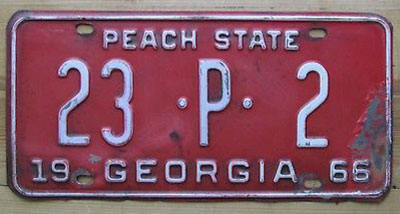 1966 issue. Embossed steel.
1966 issue. Embossed steel. 
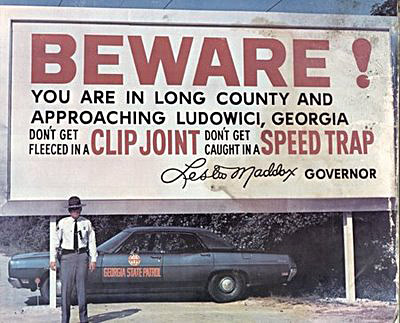
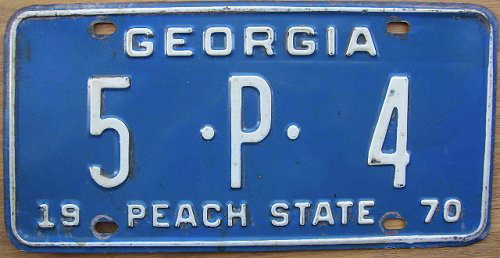 1970-issue. Embossed steel.
1970-issue. Embossed steel.
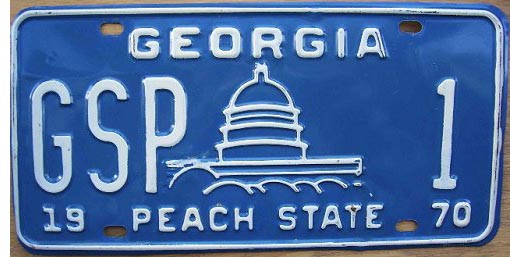 This license plate was issued to Colonel R.H. Burson, Commander of the Georgia State Patrol at that time.
This license plate was issued to Colonel R.H. Burson, Commander of the Georgia State Patrol at that time. 
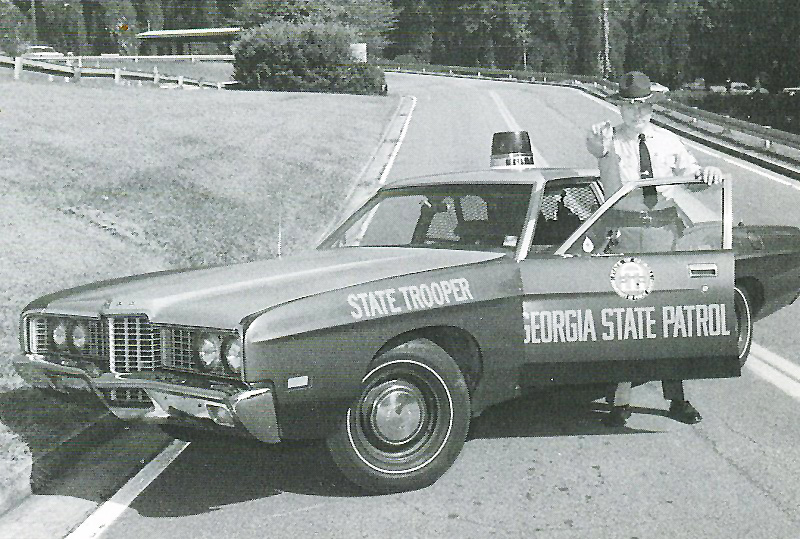
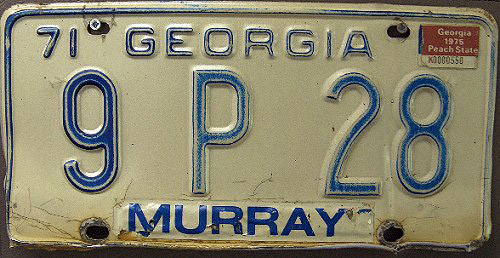 1971-1976 issue. Embossed aluminum. 5 Year Post plate. Blue over reflective white. Post 9 (Atlanta) Car 28 strangely with a Murray County decal applied over the PEACH STATE slogan.
1971-1976 issue. Embossed aluminum. 5 Year Post plate. Blue over reflective white. Post 9 (Atlanta) Car 28 strangely with a Murray County decal applied over the PEACH STATE slogan.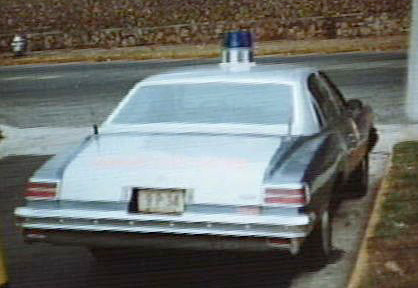 1975 GSP Pontiac LeMans with Post 9 (Atlanta) Car 34 plate
1975 GSP Pontiac LeMans with Post 9 (Atlanta) Car 34 plate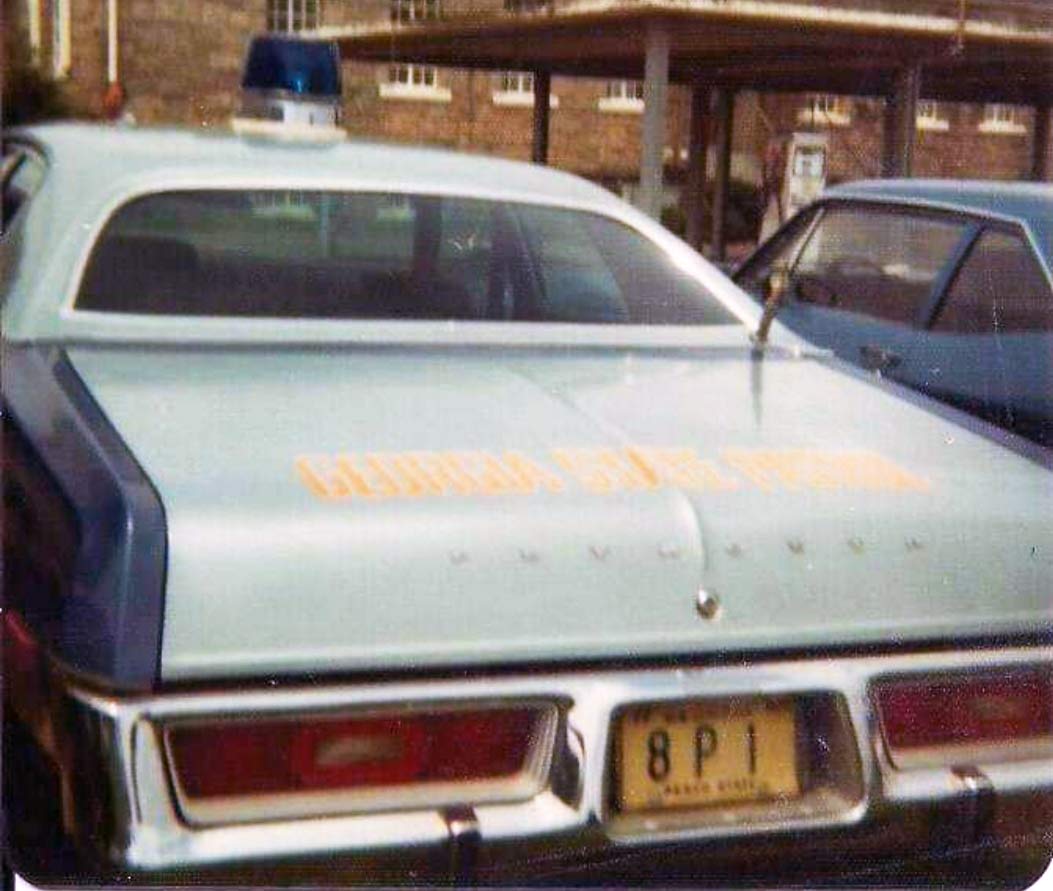 1975 Post Commander for Madison (Post 8)
1975 Post Commander for Madison (Post 8)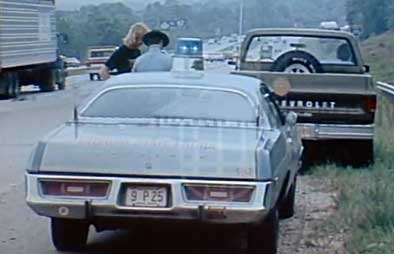 Post 9 (Atlanta) Car 25
Post 9 (Atlanta) Car 25In 1976, the multi-year 1971 license plates were ordered returned to headquarters for subsequent destruction, which is likely why these plates are extremely scarce to find these days.
The replacement plates were similar in layout and appearance with the 71 in the top left corner replaced by a 76 and the raised portions of the license plate were now painted red instead of blue.
The only other difference with this new issue, is that the use of annual validation decals in the top right corner of the plate was discontinued.
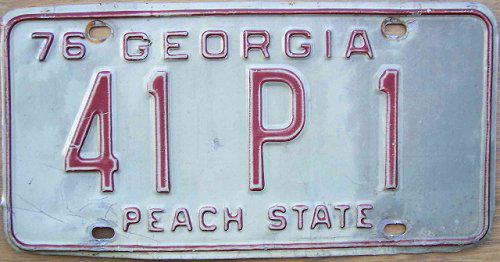 1976-1983 issue. A 1979 law allowed these "5 year plates" to be extended through 1982. Embossed aluminum.
1976-1983 issue. A 1979 law allowed these "5 year plates" to be extended through 1982. Embossed aluminum.  1976-1983 issue. A 1979 law allowed these "5 year plates" to be extended through 1982. Embossed aluminum.
1976-1983 issue. A 1979 law allowed these "5 year plates" to be extended through 1982. Embossed aluminum. 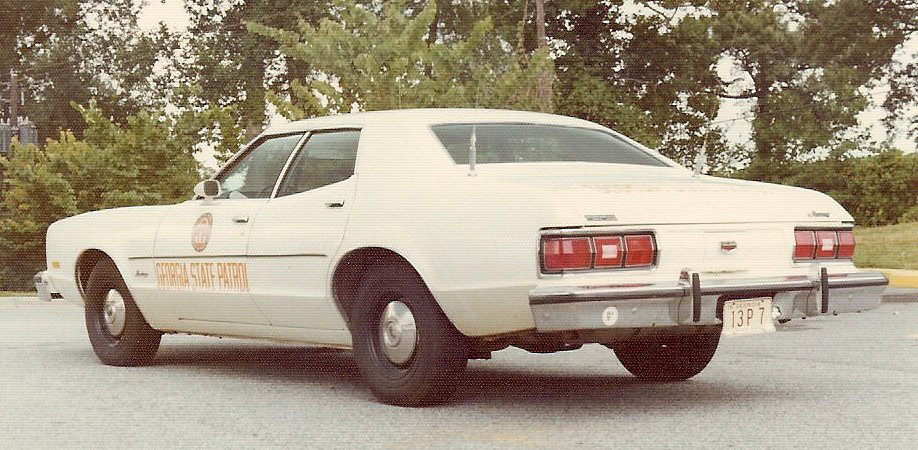
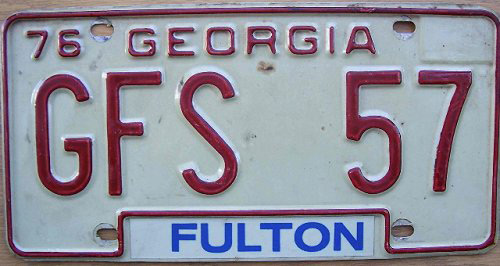 1976 “Georgia Federal and State" issue.
1976 “Georgia Federal and State" issue. 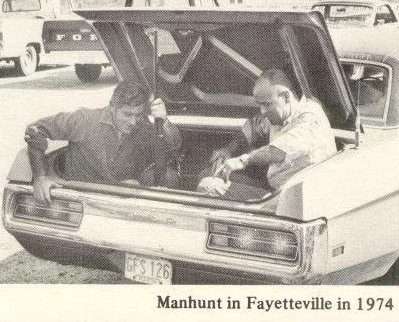
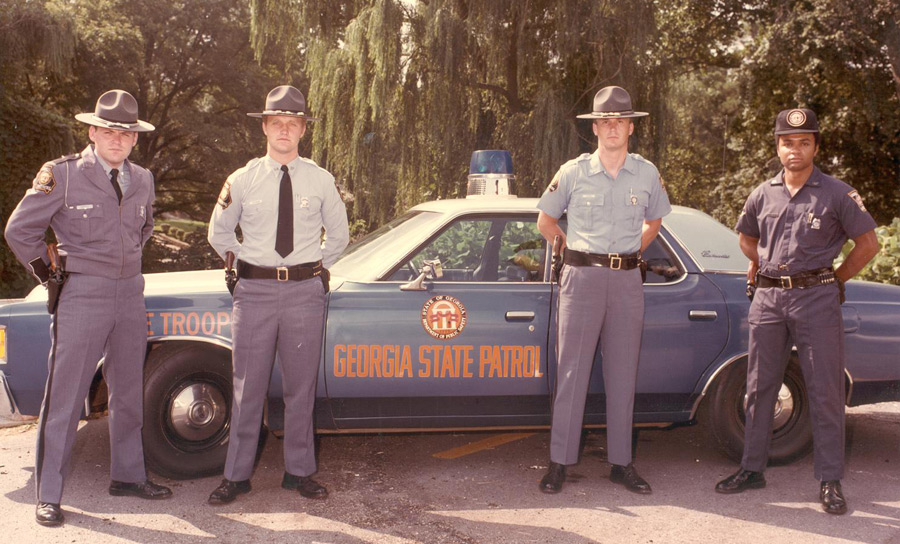
In 1983, a green over reflective white license plate was issued for the GSP in the same design and layout as regular passenger plates of the day. The use of this type by GSP was short, and so far there are no surviving specimens nor photographs to showcase this type.
The plate was run "rear only" and comprised of the top banner of the plate in silkscreened green reading 19 followed by the upper left mounting hole followed by GEORGIA in the center, then the upper right mounting hole followed by 83.
The center field of the plate comprised of the Post number followed by the letter P and an assignment number up to three digits all embossed and painted green.
The bottom legend of the plate had the state slogan "PEACH STATE" sillkscreened in green.
In 1984, a new "agency-specific graphic" license plate was issued for marked GSP vehicles.
The plate was reflective white and had the state name GEORGIA silkscreened in red large upper case font between the upper mounting holes.
The center field of the plate featured a silkscreened red state outline with the words STATE over TROOPER in upper case blue silkscreen. An embossed number up to three numerals was situated to the right center. The state slogan of "PEACH STATE" was in smaller red upper case silkscreened font between the lower mounting holes. The embossed number was purported to be the Trooper's badge and patrol car number. This type was used until the 1990 issue came out.
During this time, many GSP vehicles also sported 1983 Georgia "State Vehicle" license plates where agency-specific plates were not prepared nor issued for vehicles being immediately deployed. The plates were of the same 1983 layout as mentioned above, but the center portion of the plate had a vertical decal with the word STATE vertically justified next to the prefix GOVT stacked and embossed in green to the left of an embossed green set of numerals up to five digits. The center bottom "navel" sometimes sported a county decal (green letters over white) or no decal at all which was the correct configuration for a State Government plate. These plates were also used until 1990.
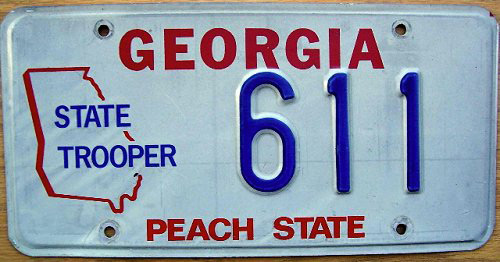 1984-1990 issue. Embossed aluminum. Silkscreened red and blue over reflective white with embossed blue numerals indicating badge/car number.
1984-1990 issue. Embossed aluminum. Silkscreened red and blue over reflective white with embossed blue numerals indicating badge/car number.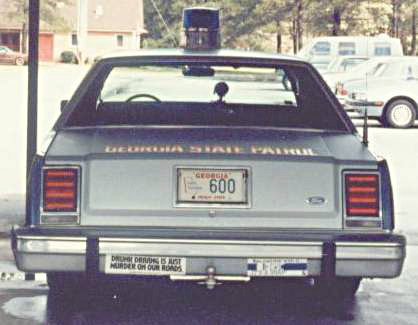
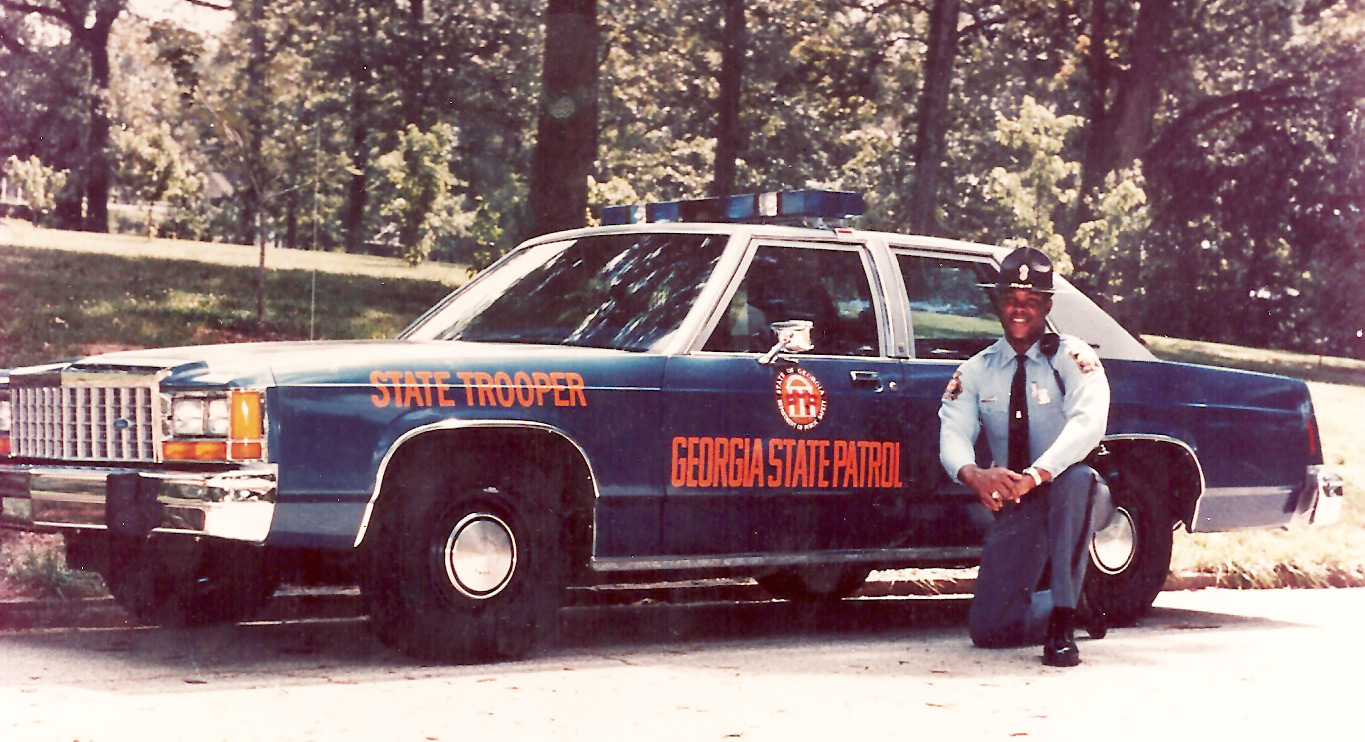
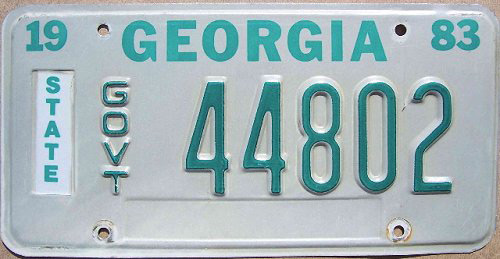 1983-1990 State Government issue.
1983-1990 State Government issue. 
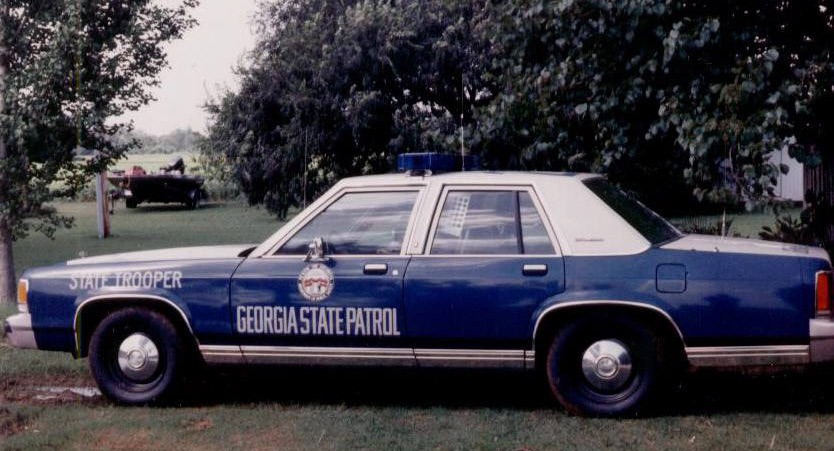
In 1990, Georgia introduced an entirely new license plate for general issue, and the GSP was also included in the new design. The plate had a reflective white background with a gradient of orange color concentrated from the bottom of the plate and fading towards the top center of the plate.
The state name was stylized green silkscreen where the letter "O" of Georgia was a design of a peach in the same shade of orange as the lower background.
The number 19 was silkscreened in green to the left of the upper left mounting hole and the number 90 was silkscreened in green to the right of the upper right mounting hole of the plate in what was known as the "sticker navel" where validation decals for subsequent years would be affixed.
The center left of the plate showcases the full color shoulder patch emblem of the GSP followed by the assignment number of the trooper/car embossed in black.
The center bottom of the plate between the lower mounting holes has a recessed rectangular "navel" with the inscription "STATE TROOPER" silkscreened in black.
As this plate was a multi year plate to be used beyond 1990, no known validation decals were issued by the GSP after 1991. This concerned many Georgia motorists and other busy-bodies who contacted the GSP to complain that GSP troopers were driving around in patrol vehicles that had "expired tags".
This prompted the GSP to issue plain white decals to first cover the 90 on the upper right corner of the plate and extended to cover the 19 of the upper left corner of the plate over time to subside the criticism.
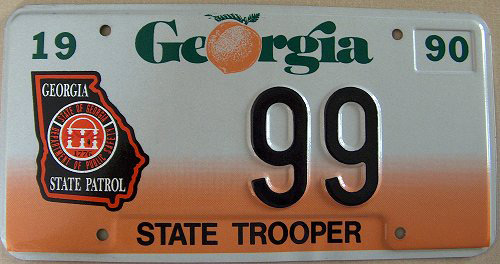 1990-1998 issue. Peach base.
1990-1998 issue. Peach base. 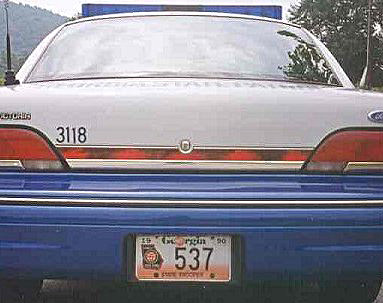
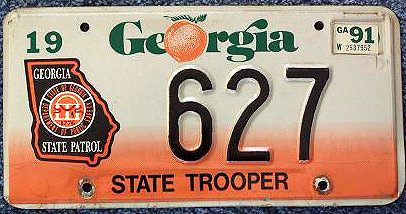 1990-1998 issue. Peach base.
1990-1998 issue. Peach base. 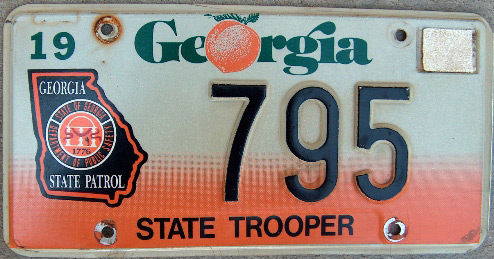 1990-1998 issue. Peach base.
1990-1998 issue. Peach base. 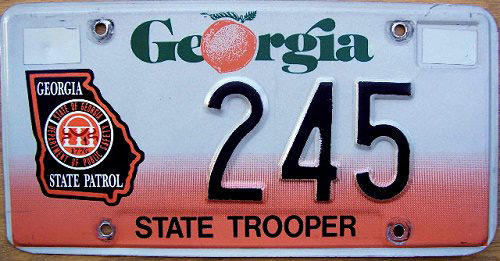 1990-1998 issue. Peach base.
1990-1998 issue. Peach base. 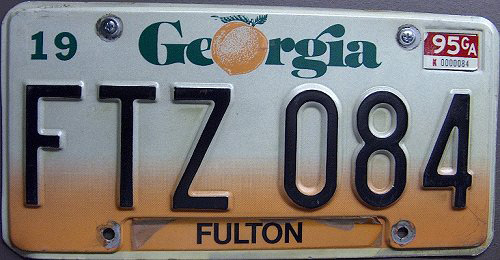 GSP Uniformed Division unmarked car plate. Badge 084 (a lieutenant out of GSP Headquarters) would have been assigned this plate. Numbering followed the following issuance blocs: Colonel 1, Lt. Colonel 2, Major 3-9, Captain 10-34, Lieutenant 35-85, and all others from 86 and up.
GSP Uniformed Division unmarked car plate. Badge 084 (a lieutenant out of GSP Headquarters) would have been assigned this plate. Numbering followed the following issuance blocs: Colonel 1, Lt. Colonel 2, Major 3-9, Captain 10-34, Lieutenant 35-85, and all others from 86 and up. 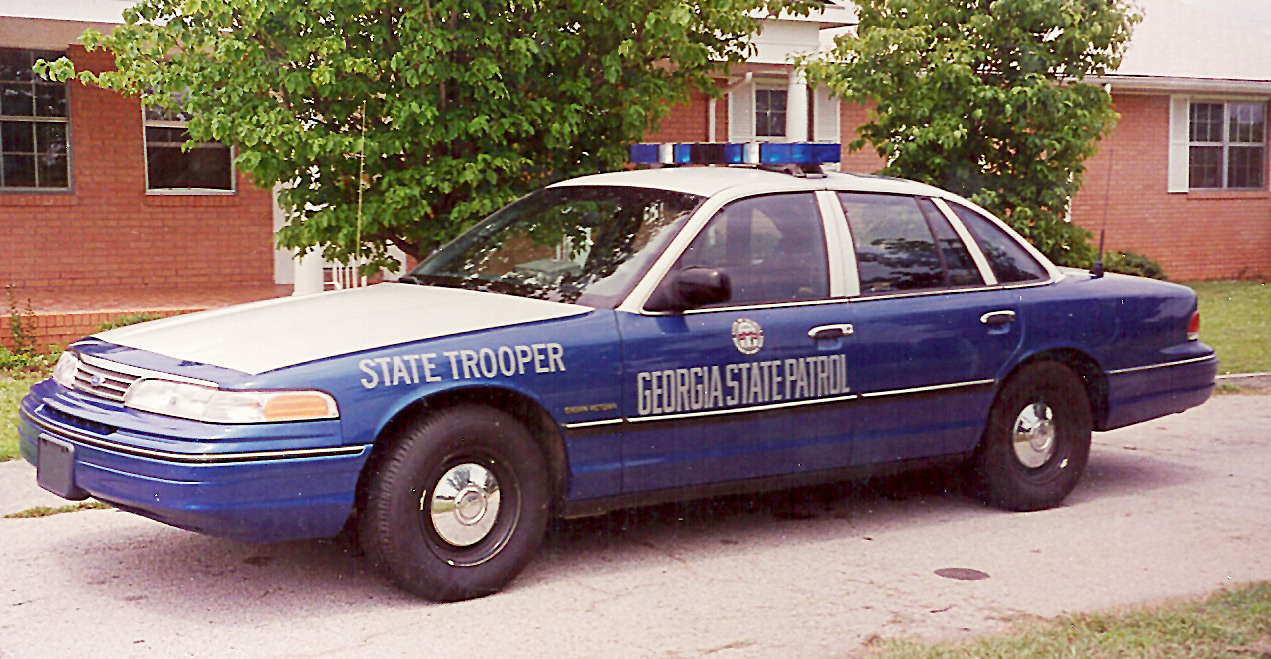
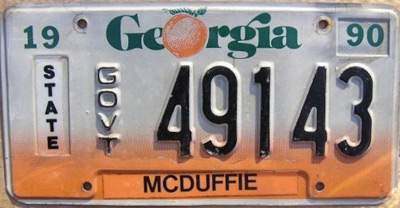 1990-1998 State Government issue. Used on GSP vehicles for rapid assignment/deployment where agency-specific plates were not available. Reflective white background with reflective and embossed green orange and black characters.
1990-1998 State Government issue. Used on GSP vehicles for rapid assignment/deployment where agency-specific plates were not available. Reflective white background with reflective and embossed green orange and black characters.
In 1998, Georgia introduced an entirely new license plate for general issue, and the GSP was also included in the new design. The plate had a reflective white background with a graphic orange and green design of a peach in the center of the plate.
The state name was stylized black copperplate silkscreen from the far left edge of the plate just below the upper left mounting hole followed by the extension of "...on my mind" in italic lower case black silkscreen font.
The center left of the plate showcases the full color shoulder patch emblem of the GSP followed by the assignment number of the trooper/car embossed in black.
The center bottom of the plate between the lower mounting holes has the inscription "STATE TROOPER" silkscreened in black.
As this plate was a multi year plate to be used beyond 1998, no known validation decals were issued by the GSP after 1998. This concerned many Georgia motorists and other busy-bodies who contacted the GSP to complain that GSP troopers were driving around in patrol vehicles that had "expired tags".
This prompted the GSP to issue plain white decals to cover the 98 on the lower right corner of the plate and extended to later completely eliminate the 98 in the lower right corner of the plate to subside the criticism.
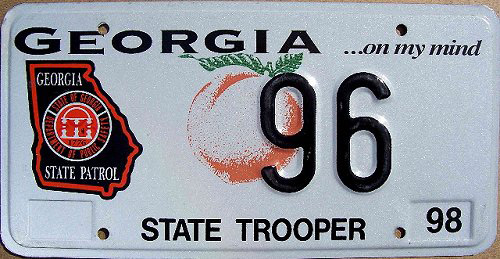 1998-2005 issue.
1998-2005 issue. 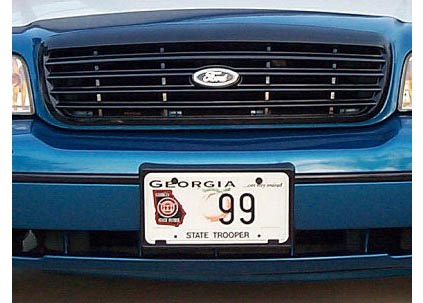 Courtesy Carlton Stallings
Courtesy Carlton Stallings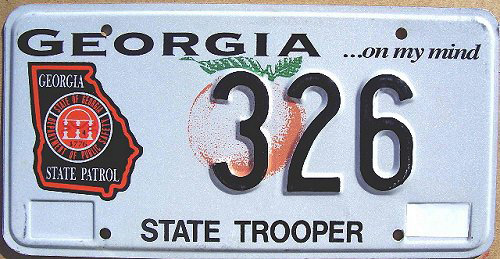 1998-2005 issue.
1998-2005 issue. 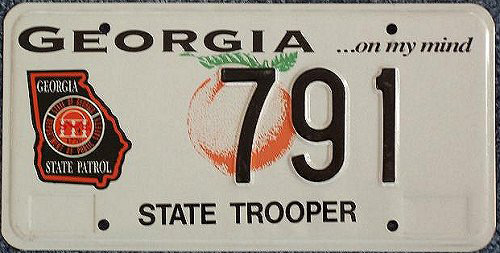 1998-2005 issue.
1998-2005 issue. 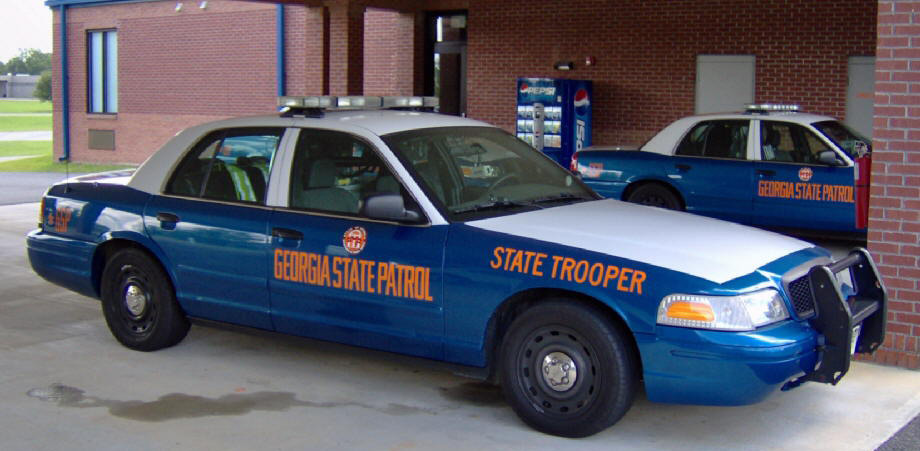
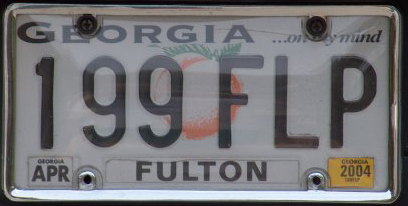 1998-2005 issue reserved number for unmarked patrol vehicles.
1998-2005 issue reserved number for unmarked patrol vehicles. 
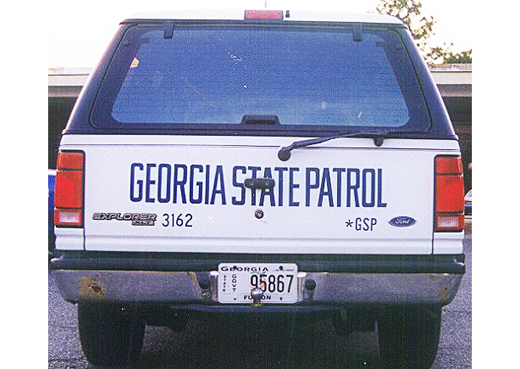 State Government plate in use on GSP vehicle.
State Government plate in use on GSP vehicle.
In 2005, the state of Georgia re-plated once again, however the GSP didn't begin using these plates until early 2005.The new plates had black embossed characters over a reflective white plate with gradient shades of gray from top to bottom. The top of the plate had www. in the top left corner and .gov in the top right corner all in lower case letters. The state name was positioned in the center in larger upper case letters. The lettering along the top is white with black outline. The ubiquitous GSP shoulder patch emblem took-up its usual spot on the left center of the plate ahead of the embossed assignment number. The legend STATE TROOPER occupies the bottom center of the plate in black. A grey solid rectangle occupies the bottom left decal navel. The GSP learned from their previous errors and ensured that no year could be showing on the plate requiring corrective action in the years hence.
These plates began being phased-out in late 2007.
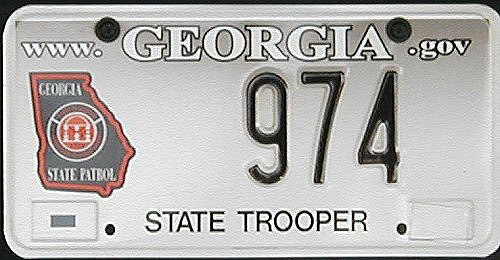 2005-2007 issue.
2005-2007 issue.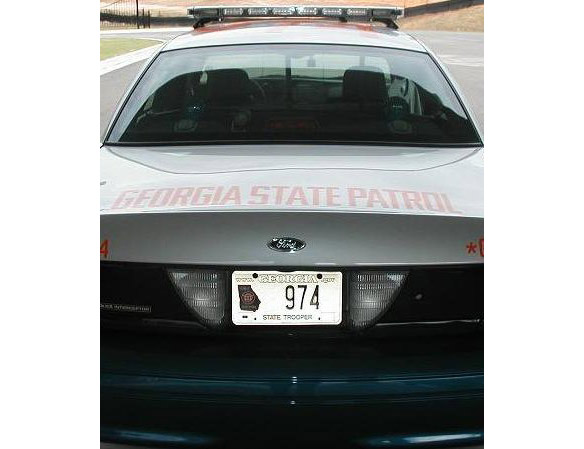
 2005-2007 issue.
2005-2007 issue.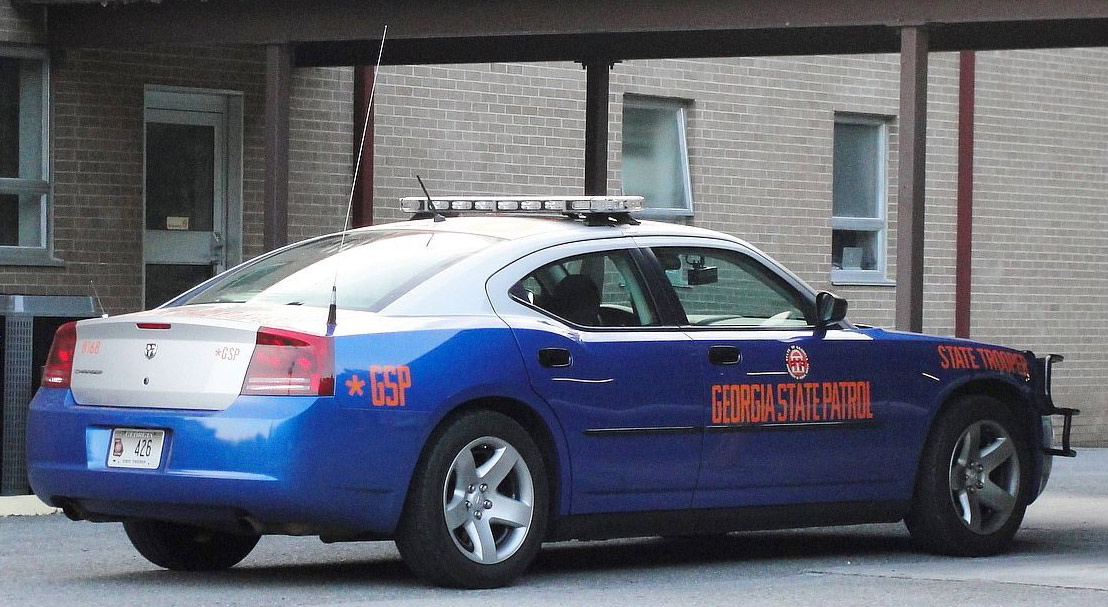
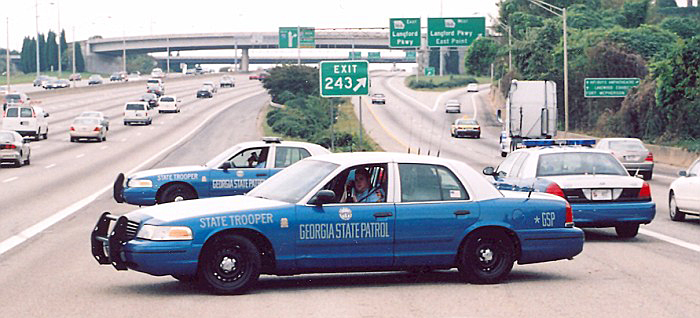
In 2007, the state of Georgia issued another license plate design. This time with black characters over a reflective white background. The state name appeared silkscreened in a large upper case font at the top center of the plate followed by .gov.
The GSP emblem in full color once again occupied the left center of the plate followed by the assignment number embossed in the center. STATE TROOPER also silkscreened at the bottom center of the plate. A validation decal navel occupied the bottom right corner of the plate with Place Decal Here screened in the center.
These plates had a step-border and were used until 2012.
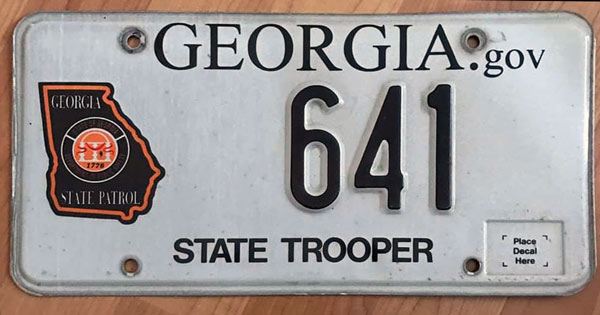 2007-2012 issue. Embossed aluminum.
2007-2012 issue. Embossed aluminum.
Sometime in 2012-2013, the GSP went to an "all flat", all-silkscreened plate with no border characteristics. Although almost identical to the previous issue without any embossed features whatsoever, the .gov after the state name was dropped and a small bar code appeared at the bottom left corner margin. The "Place Decal Here" segment at the bottom right corner margin also remained.
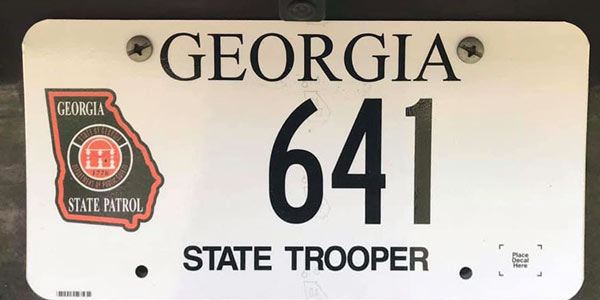 2013-current issue.
2013-current issue. 
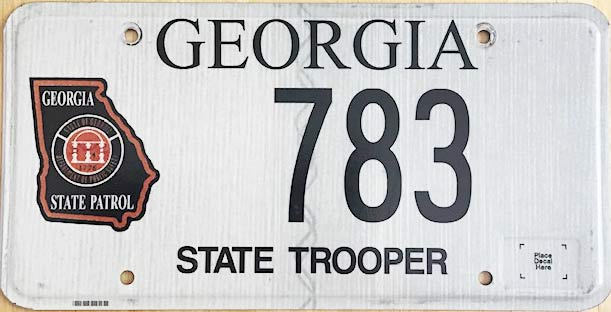 Circa 2018-Current issue.
Circa 2018-Current issue. 
In 2022, the Georgia Department of Public Safety celebrated 85 years serving the people of the Peach State.
Part of the celebration was the introduction of special license plates to commemmorate the occasion to be run on the front of certain DPS vehicles including Georgia State Patrol vehicles.
There were three different types sharing the same design/layout.
The base layout for these flat silkscreened license plates was a white background with a black border edge. The top left corner is inscribed 20 and the top right corner is inscribed 22. "Serving 1937 Since" is situated in the top center of the plate. GEORGIA is inscribed in large black letters in the bottom center of the plate. In the center left field of the plate is a yellow roundel edged in black with "State of Georgia" inscribed on the top half, "Department of Public Safety" inscribed on the lower half with 1937 at the 9'o'clock position and 2022 at the 3 o'clock position.
The center of the roundel features an image of the state superimposed by the state flag of Georgia and the Capital Dome. Below the bottom edge of the roundel is a rocker that reads: "85th ANNIVERSARY" in yellow over black.
There are three different versions of this base that have the following as the center field of each plate: DPS, 85th and in the case of some GSP vehicles, the Trooper's ID number.
 2022- DPS 85th Anniversary with Trooper ID number
2022- DPS 85th Anniversary with Trooper ID number
(Courtesy Allan Attanasio)
In Georgia, there has been no requirement for motor vehicles to display a front license plate for many years. As a result, most GSP vehicles have never displayed a front plate. One of the popular front plates used by the GSP was the Georgia state flag plate used from 1956 to 2001.
Many Georgia residents found the inclusion of the Confederate Battle Flag offensive and representative of a distasteful segment of Georgia history. For years the design of the flag was challenged and in January, 2001, the Georgia House and Senate voted on a new design intended to recognize the Confederate Battle Flag's historical significance while minimizing its prominence as representative of the state of Georgia. Governor Roy Barnes signed the legislation that had made its way through the Georgia Legislature in only six days and a new flag was quietly raised over the state capital on January 31. The use of these plates on the front of GSP vehicles was no longer permitted.
Since then, the GSP has chiefly opted to not run any plates on the front of the majority of GSP vehicles.
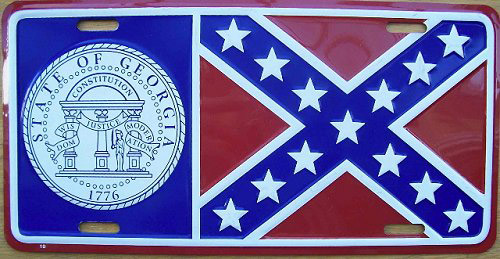 1956-2001 embossed state flag issue.
1956-2001 embossed state flag issue.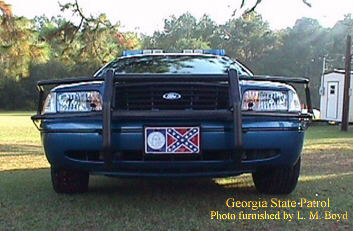 (Courtesy L.M. Boyd)
(Courtesy L.M. Boyd)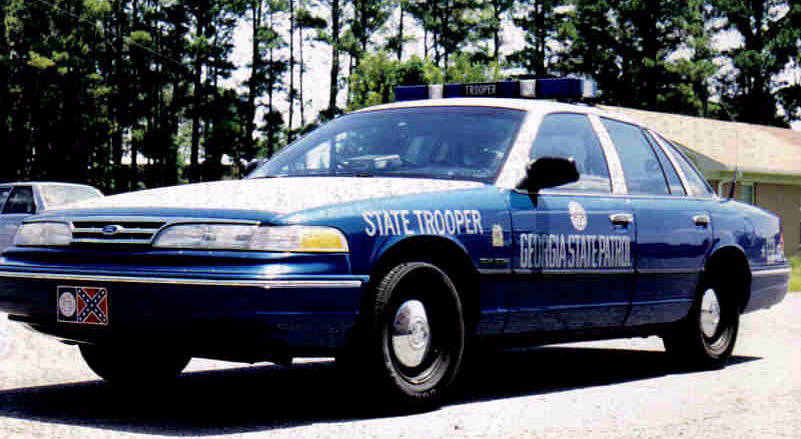
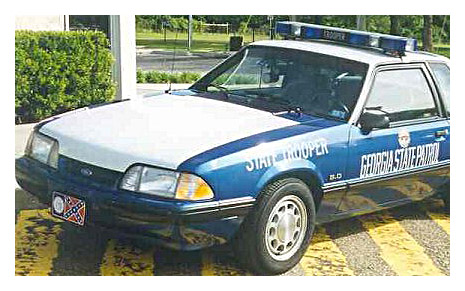
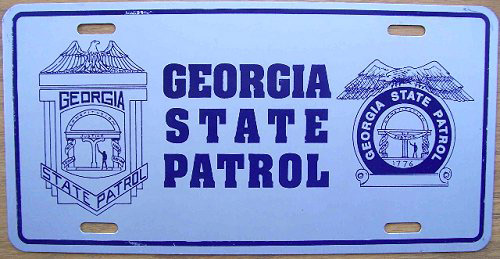 Flat screened aluminum.
Flat screened aluminum. 
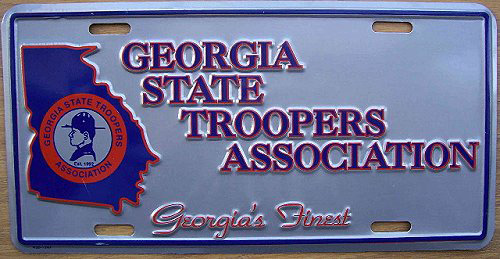 Georgia State Troopers Association "booster" plate.
Georgia State Troopers Association "booster" plate. 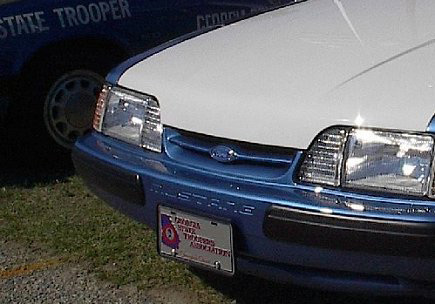
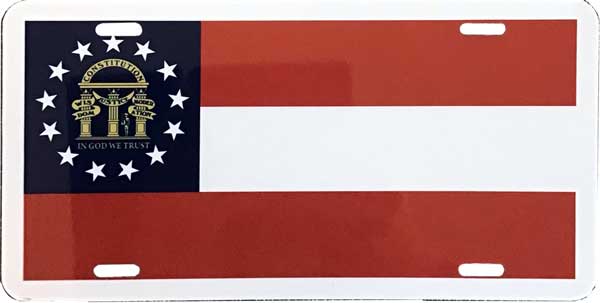 Redesigned State Flag also run on the front of some GSP vehicles.
Redesigned State Flag also run on the front of some GSP vehicles.
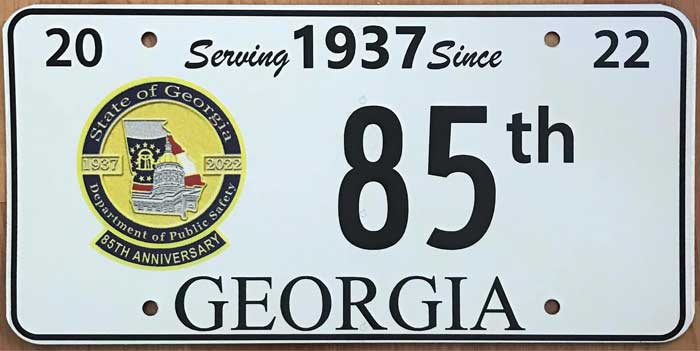 2022 85th Anniversary of Georgia Department of Public Safety front booster plate. Silkscreened metal
2022 85th Anniversary of Georgia Department of Public Safety front booster plate. Silkscreened metal 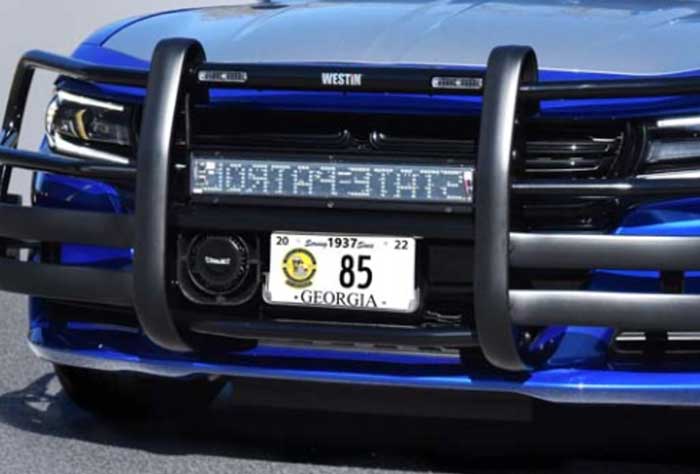
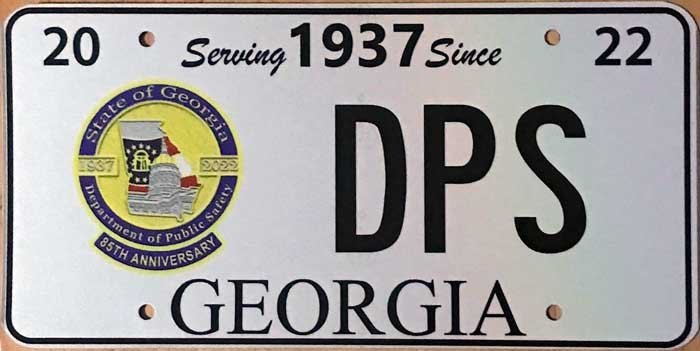 2022 85th Anniversary of Georgia Department of Public Safety front booster plate. Silkscreened metal
2022 85th Anniversary of Georgia Department of Public Safety front booster plate. Silkscreened metal 
On July 1 1987, The Georgia State Patrol commenced the Aggressive Criminal Enforcement or ACE program. Public Safety Commissioner Curtis D. Earp Jr started the Excellent Achievement Recognition Policy (EARP) in an effort to recognize GSP troopers who did good work.
The Program was patterened after the Ohio State Highway Patrol's ACE program that was instituted with great success in 1972. The ACE program awards a trooper with a lightning bolt decal for the driver's side door of his/her patrol car each time the trooper effects a felony arrest by apprehending a fugitive, recovers a stolen car, identifies an abused or neglected child or a child being sought by the authorities.
Five lightning bolts within a year made the Trooper an ACE, just as five confirmed kills made a World War One fighter pilot an ace. This five-bolt recognition was the issuance of a GSP ACE license plate that could be run on Trooper's patrol car in lieu of the regular GSP plate. The plate was reflective white, and with the exception of the step border and recessed decal navels, was entirely silkscreened. The state name was centered at the top in upper-case dark blue letters. The center left of the plate had the words AGGRESSIVE (over) CRIMINAL (over) ENFORCEMENT in upper case dark blue letters with the first letter of each word in bold to accentuate the acronym. The words STATE PATROL occupied the center bottom portion of the plate also in upper-case dark blue letters along with the last two digits of the year in the bottom right decal navel in dark blue silkscreen. The lightning bolts were red for 1987 and gold for 1988 and 1989 and were applied decals.
The ACE Trooper then became eligible for the Troop Award for the most lightning bolts earned. A merit pay increase was part of the arrangement and a chance to compete for the statewide "Blue Max" award, making the Trooper the "Ace of Aces". The first Blue Max recipient for the GSP was TFC Gene Scarbrough of Post 13 (Tifton)
In 1988, the number of required felony arrests/recoveries jumped from five to twenty five, which is when the bolt color went from red to gold. Despite this personal recognition, the ACE license plates were property of the Georgia Department of Public Safety and had to be surrendered upon leaving the employ of the GSP. Many ACE license plates were "lost" before that could happen.
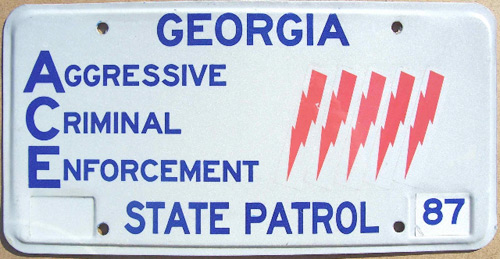 1987 ACE plate. Achieved by 5 felony arrests within
one year involving recovery of stolen vehicles. Each red lightning bolt signifies
each one of those arrests. These award plates are highly coveted as a hard-
earned trophy for the recipient's intrepid work above and beyond
the regular call of duty.
1987 ACE plate. Achieved by 5 felony arrests within
one year involving recovery of stolen vehicles. Each red lightning bolt signifies
each one of those arrests. These award plates are highly coveted as a hard-
earned trophy for the recipient's intrepid work above and beyond
the regular call of duty.
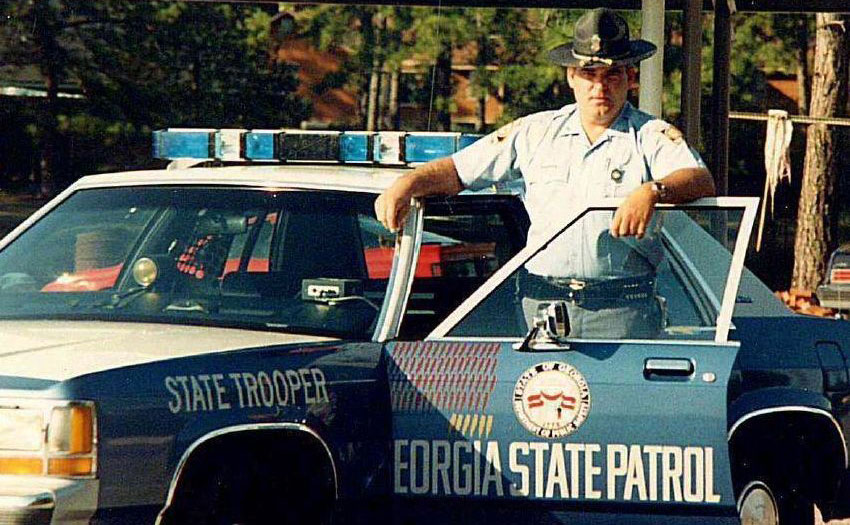 A veritable lightning storm of ACE bolts on the driver's door of this Trooper's car!
A veritable lightning storm of ACE bolts on the driver's door of this Trooper's car! 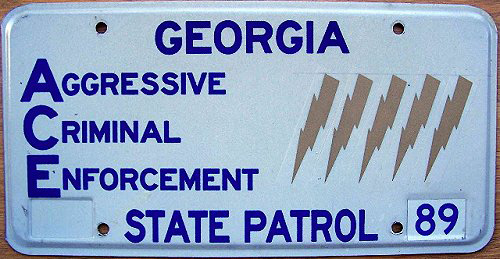 1989 ACE plate. Achieved by 25 felony arrests within
one year involving recovery of stolen vehicles. Each gold lightning bolt signifies
5 of those arrests. These award plates are highly coveted as a hard-
earned trophy for the recipient's intrepid work above and beyond
the regular call of duty.
1989 ACE plate. Achieved by 25 felony arrests within
one year involving recovery of stolen vehicles. Each gold lightning bolt signifies
5 of those arrests. These award plates are highly coveted as a hard-
earned trophy for the recipient's intrepid work above and beyond
the regular call of duty.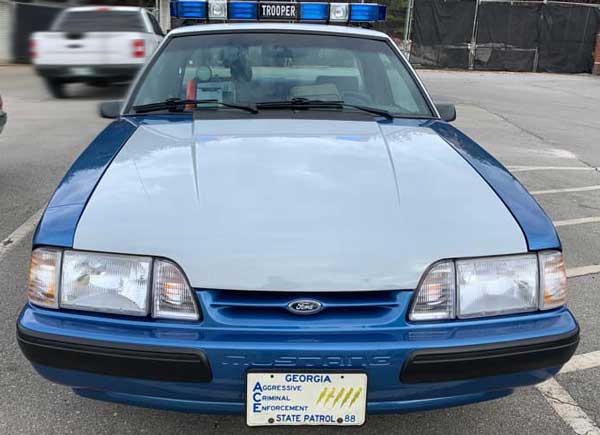 1988 GASP ACE
1988 GASP ACE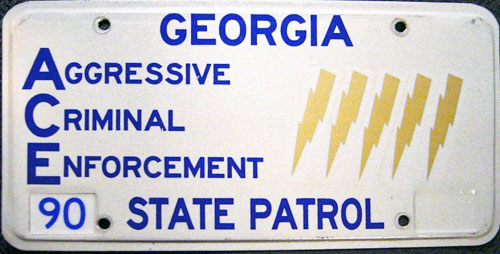 1990 ACE plate. Achieved by 25 felony arrests within
one year involving recovery of stolen vehicles. Each gold lightning bolt signifies
5 of those arrests. These award plates are highly coveted as a hard-
earned trophy for the recipient's intrepid work above and beyond
the regular call of duty.
1990 ACE plate. Achieved by 25 felony arrests within
one year involving recovery of stolen vehicles. Each gold lightning bolt signifies
5 of those arrests. These award plates are highly coveted as a hard-
earned trophy for the recipient's intrepid work above and beyond
the regular call of duty.
The Georgia State Patrol Aggressive Criminal Enforcement program seemed to have gone dormant for a number of years but was revived around February of 2022.
The new Georgia SP ACE license plates in their more current form are entirely flat silkscreened aluminum.
The license plate is white with a black line border (some versions have no black line border). GEORGIA STATE TROOPER is inscribed in dark blue along the top center of the plate.
In the far left center field of the plate is a full-color GSP shoulder patch emblem and on the far right center field of the plate is a silver and orange rendition of the GSP badge. The entire center field of the license plate is left blank for affixing the lightning bolt decals.
Below that in large blue letters is A.C.E. and below that in red inscribed between the lower mounting holes is AGGESSIVE CRIMINAL ENFORCEMENT
Georgia ACE license plates have different color coding for the lightning bolts affixed to the plates.
Any serving Georgia State Patrol Trooper is eligible for this recognition of exemplary service in the GSP's ACE Program.
There are four different colors for four categories considered.
The colors are orange, bronze, silver and gold.
ACE award recipients receive one lightning bolt for each category once the specified number of arrests have been obtained in that category.
For example, a Trooper with 101 DUI arrests would receive one gold Lightning bolt. A Trooper with 101 DUI arrests and 15 felony drug arrests would receive one gold lightning bolt and one silver lightning bolt.
Each lightning bolt is to be affixed to the ACE license plate only (not on the car's fenders/doors as in years past)
The ACE license plate is run on the front of the patrol vehicle only for one calendar year.
If the Trooper fails to obtain any lightning bolts during the subsequent calendar year that the ACE awared was obtaineed, the ACE license plate must be removed from the patrol vehicle.
This ensures motivation and incentive to carry-on with top-drawer performance year after year.
ACE LIGHTNING BOLT COLORS AND CRITERIA:
ORANGE: 25 Impaired Driving arrests, 5 State Felony arrests, 5 Felony Drug arrests, 5 Stolen Vehicle Recoveries/arrests
BRONZE: 50 Impaired Driving arrests, 10 State Felony arrests, 10 Felony Drug arrests, 10 Stolen Vehicle Recoveries/arrests
SILVER: 75 Impaired Driving arrests, 15 State Felony arrests, 15 Felony Drug arrests, 15 Stolen Vehicle Recoveries/arrests
GOLD: 100 Impaired Driving arrests, 20+ State Felony arrests, 20+ Felony Drug arrests, 20+ Stolen Vehicle Recoveries/arrests
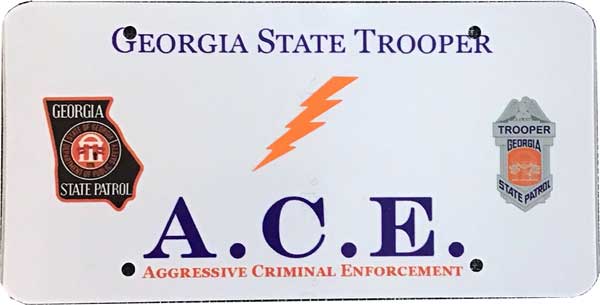 2022- Current issue ACE.
2022- Current issue ACE.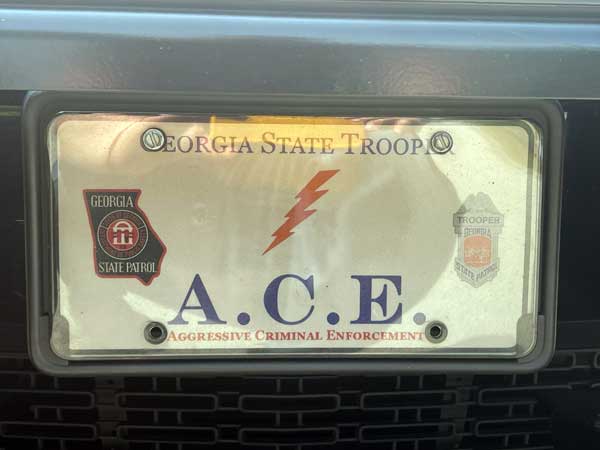 When you earn it..you protect it !
When you earn it..you protect it ! 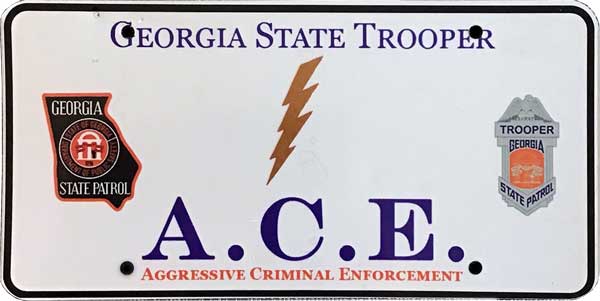 2022- Current issue ACE.
2022- Current issue ACE.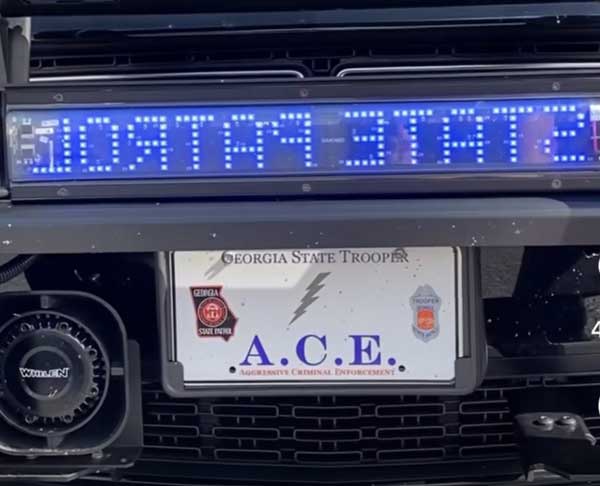 Silver lightning bolt...getting there!
Silver lightning bolt...getting there!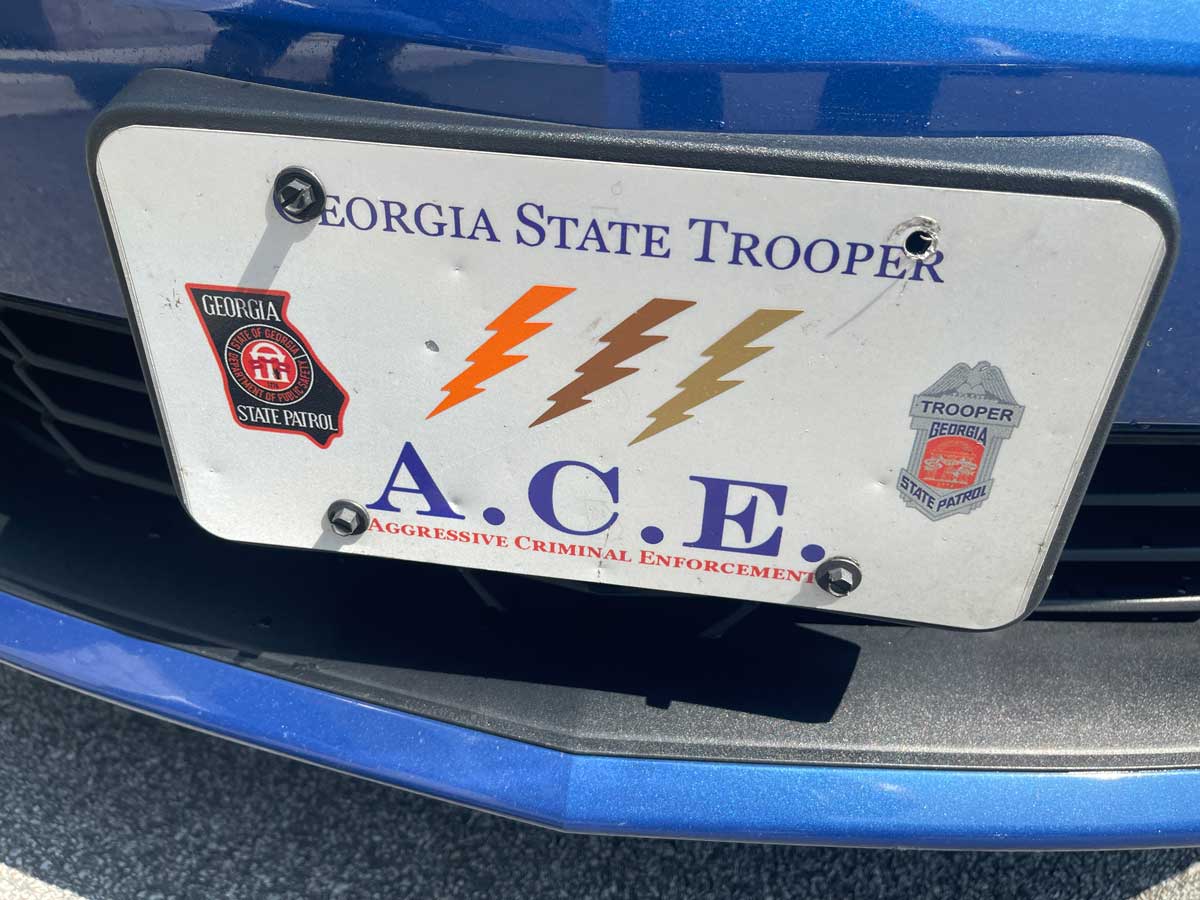 Orange, bronze and GOLD lightning bolts !....no silver?....what a slouch ...
Orange, bronze and GOLD lightning bolts !....no silver?....what a slouch ... 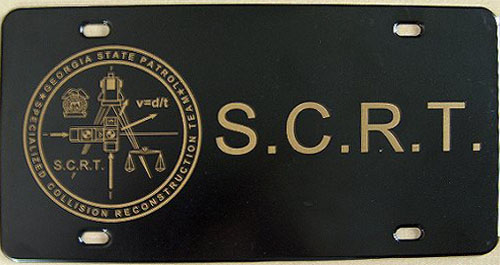 Front "booster" plate used on vehicles assigned to GSP Specialized
Collision Reconstruction Team
Front "booster" plate used on vehicles assigned to GSP Specialized
Collision Reconstruction Team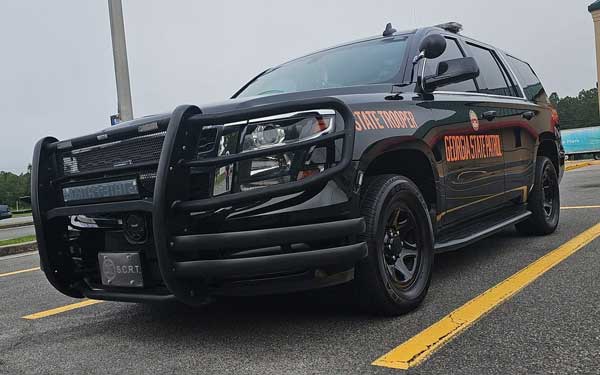 (Courtesy Brian Allen)
(Courtesy Brian Allen) 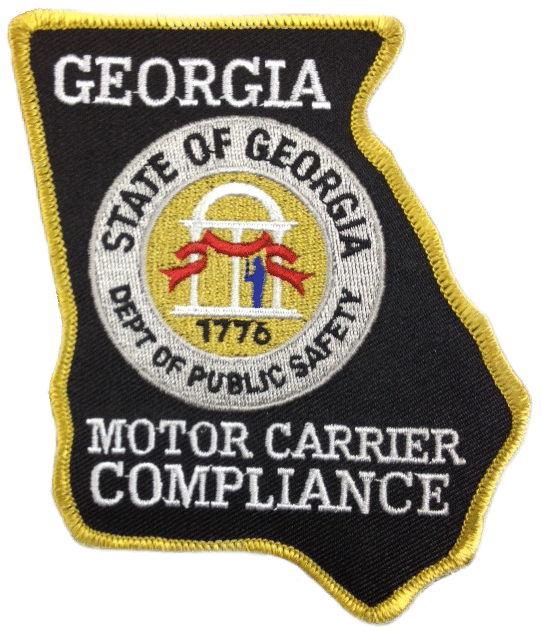 The Department of Public Safety is the State Lead Agency for the Federal Motor Carrier Safety Assistance Program (MCSAP). Under this program, DPS/MCCD conducts safety inspections of commercial motor vehicles (primarily trucks and buses), inspects highway shipments of hazardous materials, and performs compliance reviews (safety performance audits) on motor carriers. The Department adopts and enforces driver and vehicle safety regulations and hazardous materials regulations as part of this program.
DPS/MCCD also enforces laws and regulations that govern vehicle size (height, width, and length) and vehicle weight. The Department operates 19 permanent weight and inspection stations throughout the State, primarily on Interstate highways. The stations are equipped with "weigh in motion" systems to screen vehicles. Selected vehicles are then weighed and measured to determine compliance. On bypass and side roads, MCCD Officers use portable scales to weigh selected vehicles.
Another role for the Motor Carrier Compliance Division is the enforcement of High Occupancy Vehicle (HOV) lanes in the metropolitan Atlanta area. MCCD Officers patrol the highways, identifying and apprehending those who use the HOV lanes improperly.
The Motor Carrier Compliance Division also performs a number of other tasks, including inspecting diesel powered over-the-road vehicles for dyed fuel (indicating the use of "off-road" diesel), rendering assistance at accident scenes, providing aid in disasters, and an aggressive public outreach program.
MCCD Officers are trained and certified in accordance with standards of the Georgia Peace Officer Standards and Training (POST) Council, and have full arrest powers in the performance of their duties. In addition, because of the detailed regulations governing commercial vehicle and driver safety, size, weight, and hazardous materials, MCCD Officers spend many hours each year in training in these specialized topics.
The Department of Public Safety is the State Lead Agency for the Federal Motor Carrier Safety Assistance Program (MCSAP). Under this program, DPS/MCCD conducts safety inspections of commercial motor vehicles (primarily trucks and buses), inspects highway shipments of hazardous materials, and performs compliance reviews (safety performance audits) on motor carriers. The Department adopts and enforces driver and vehicle safety regulations and hazardous materials regulations as part of this program.
DPS/MCCD also enforces laws and regulations that govern vehicle size (height, width, and length) and vehicle weight. The Department operates 19 permanent weight and inspection stations throughout the State, primarily on Interstate highways. The stations are equipped with "weigh in motion" systems to screen vehicles. Selected vehicles are then weighed and measured to determine compliance. On bypass and side roads, MCCD Officers use portable scales to weigh selected vehicles.
Another role for the Motor Carrier Compliance Division is the enforcement of High Occupancy Vehicle (HOV) lanes in the metropolitan Atlanta area. MCCD Officers patrol the highways, identifying and apprehending those who use the HOV lanes improperly.
The Motor Carrier Compliance Division also performs a number of other tasks, including inspecting diesel powered over-the-road vehicles for dyed fuel (indicating the use of "off-road" diesel), rendering assistance at accident scenes, providing aid in disasters, and an aggressive public outreach program.
MCCD Officers are trained and certified in accordance with standards of the Georgia Peace Officer Standards and Training (POST) Council, and have full arrest powers in the performance of their duties. In addition, because of the detailed regulations governing commercial vehicle and driver safety, size, weight, and hazardous materials, MCCD Officers spend many hours each year in training in these specialized topics.
Current license plates used on the vehicles of MCCD personnel are similar to those of the State Patrol. The background of the plate is white. The shoulder patch emblem of the agency is screened in full color to the left of the black embossed badge number of the officer.
STATE OFFICER is silkscreened in black at the lower center of the plate.
 2005-2007 Motor Carrier issue.
2005-2007 Motor Carrier issue.
 2008-Current issue MCCD license plate. Embossed aluminum.
2008-Current issue MCCD license plate. Embossed aluminum.
The Georgia State Patrol did not have any motorcycles in their fleet until 1941. There were no special license plates issued for the patrol motors at that time. The use of motorcycles on patrol was gradually phased-out until a limited re-introduction in the mid 1970's chiefly for parades and escort duties.
More recently, there has been a resurgence of motorcycle use on patrol by the GSP.
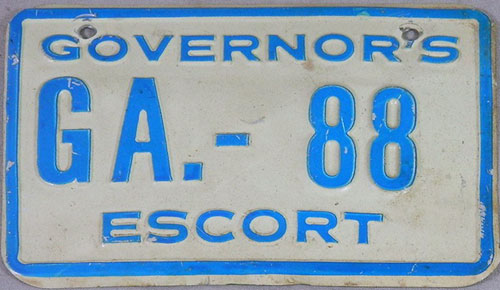 Specially-made circa 1974 Governor's Escort plate made for Lieutenant Harry Embry. Lt. Embry was issued GSP badge #88 and a very large man known as "Big 88". He was the driver and security escort for the state governor at the time.
Specially-made circa 1974 Governor's Escort plate made for Lieutenant Harry Embry. Lt. Embry was issued GSP badge #88 and a very large man known as "Big 88". He was the driver and security escort for the state governor at the time.
 1983-1990 Government Motorcycle issue.
1983-1990 Government Motorcycle issue.

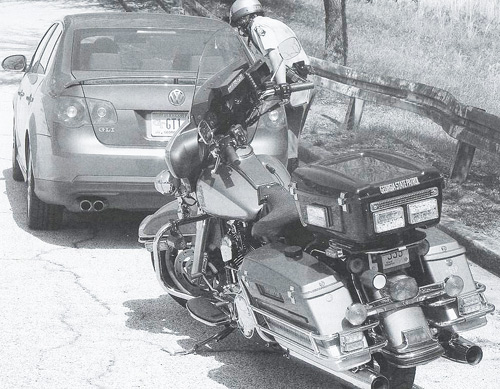


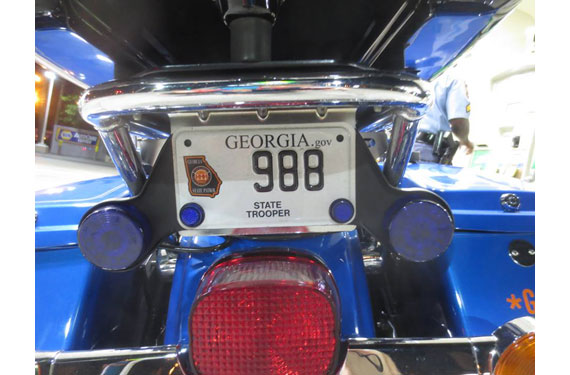 Current issue GSP motorcycle license plate. Badge 988
Current issue GSP motorcycle license plate. Badge 988